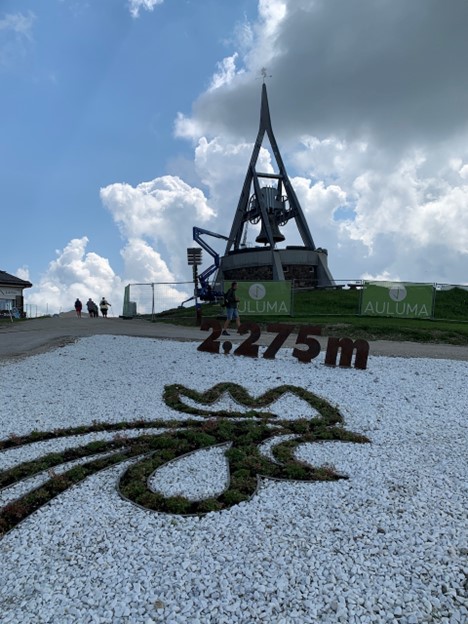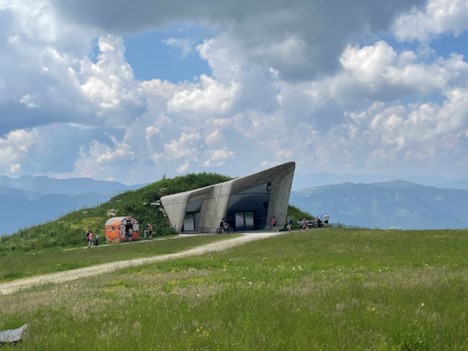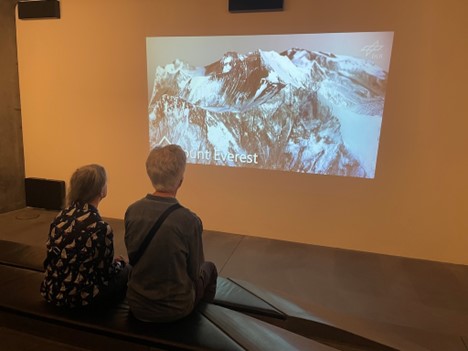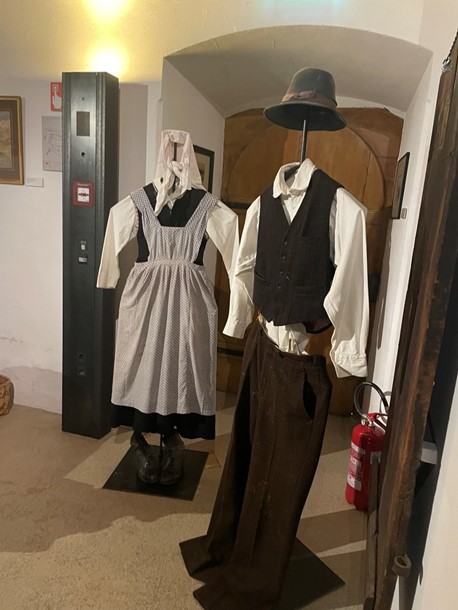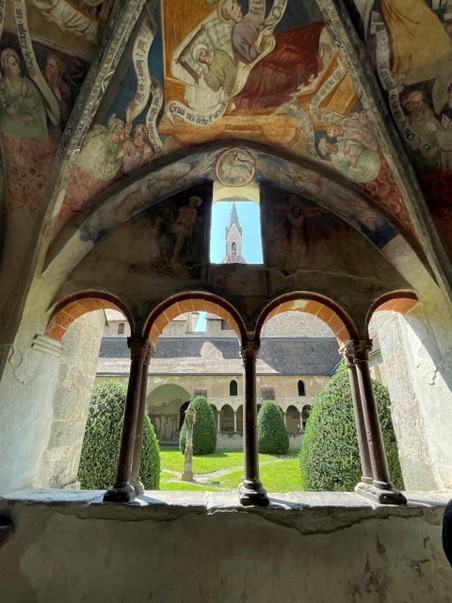Several days after the hike in the High Alps of Austria, I spent four days in Brixen (South-Tyrol, Italy) with my husband David and two of our dear friends. Stephanie, being an excellent planner, arranged our train tickets, accommodation and also almost all the sites we visited – it was a very relaxing and interesting trip.
.
.
.
.
.
Robert, Stephanie, David and I with the Dolomites in the background
.
.
Our main destination was the Messner Museum Corones on the mountain plateau Kronplatz (2275m). Reinhold Messner and Peter Habeler were the first human beings who climbed Mount Everest without supplemental oxygen (May 8, 1978). it was considered impossible to do that, like many other things in mountaineering.
.
.
.
.
.
At least four gondolas from all sides are leading up to the mountain plateau. In the center of this plateau stands a bell tower. Several restaurants are geared for the masses of people in winter time. It is not only a paradise for skiers and snow boarders, but also a great place for para gliders and hang gliders to take off.
The Messner museum is an architectonic masterpiece, built by Zahar Hadid. It fits perfectly into the surroundings. The inside shows traditional mountaineering shaped by Reinhold Messner.
.
.
.
.
.
View to the Messner Museum (built 2016), representing 250 years of mountaineering with its triumphs and tragedies. Photos and works of art of the great and famous mountains of the world are combined with relics from extraordinary climbing expeditions.
.
.
.
.
.
Entrance to the Messner Museum
.
.
.
.
.
This photo is taken from inside of the museum looking down to lower floors and the terrace. On one of the huge walls, I saw a quote by Buddha:”You cannot walk the way unless you become the way”. Becoming the way by walking the way – how beautifully expressed!
.
.
.
.
.
Watching a movie with Mt. Everest and other famous mountains climbed by people who dared to break the wall of impossibility. Reinhold Messner says “Das einzige richtige Ziel beim Bergsteigen gibt es nicht, es gibt nur Möglichkeiten am Unmöglichen vorbei”. (There is no one way to reach a goal in mountaineering, there are only possibilities to pass the impossible).
.
.
.
Mountains – built for the human race –
are at once their schools and cathedrals
(John Ruskin)
.
.
Reinhold Messner, born 1944, proved many times that the impossible is possible. I am impressed how he overcomes his fears and especially challenges and bypasses the basic instinct of survival by pushing himself to the edge of existence. He is not only the most famous person in mountaineering but he also founded six museums. They were curated by his daughter, who is an art historian. The artistic layout of the museum inside was impressive.
We had time to visit another museum in the nearby town Bruneck. It is located in a castle and shows the culture and way of living of mountain people all over the world.
.
.
.
.
.
The Bruneck castle with the inner court
.
.
.
.
.
Before entering the main museum, we went to Nirvana – a long walkway down to the bottom of a tower. The walkway was decorated by Buddhist sculptures and Thangkas. Three large pillows were inviting people to rest at the end of the walkway, a room only lit by the light falling through the tiny windows. We took a long rest and enjoyed the silence.
.
.
.
.
.
My beautiful friend Stephanie
.
.
.
.
.
The museum contains beautiful artifacts, which are speaking for themselves. One of the objects is this Nomad tent used by Tibetan Mountain people. A writing beside the tent describes their culture, which is deeply rooted in equanimity and simplicity. Their belief in their own Buddha nature helps them to withstand immense difficulties and forms their culture, being joyful and happy people.
.
.
.
.
.
Most of the time not words, but objects were used to describe the people of the mountains. However, the little words used sometimes where very impressive – like on this glass door. “Silence, depth and dignity, these are the values which belong not only to mountaineering, but also to Buddhism.
.
.
.
.
.
Traditional Austrian outfits of people living in the High Alps
.
.
The next day, we used a gondola to reach the top of the Plose mountain. The gondola is only 7 km outside of Brixen. Besides having the most spectacular view, is also a paradise for little children. A three km long hike to a beautiful restaurant offers fun activities for children of all ages. My two little grandchildren would have loved this hike.
.
.
.
.
.
Fun activities for older children
.
.
.
.
.
Different viewpoint
.
.
On the last day, we explored the town Brixen. Our first destination was the cloister beside the cathedral of Brixen, an 18th century baroque building.
.
.
.
.
.
Cathedral plaza with water fountain offering drinkable water
.
.
.
.
.
View from the cloister into the inner court
.
.
.
.
.
The Gothic vaulting was covered by 15th century murals and Latin inscriptions. I was in awe.
.
.
.
.
.
Beside the depiction of many other animals, this white elephant with the body of a horse was the most intriguing fresco. In comparison to the white elephant in Asia, symbolizing wisdom and compassion, this animal is depicted as a war animal. It carries a tower with soldiers on the top. Obviously, the artist never saw an elephant and painted it according to stories he had heard.
Another fascinating sight was a huge sculpture of a male head, laying close to the altar in the Brixen cathedral. I
.
.
.
.
.
Franz Reinisch was a Catholic priest growing up in South Tirol who was sentenced to death and beheaded on August 21, 1942. He followed his conscience and did not swear an oath of allegiance to Adolf Hitler. Out of 18 million soldiers, he was one of the few who had the strength and courage to stand up and speak out his truth by risking his life – very inspiring!
.
.
.
.
.
Sacred Mountain Säben
.
.
In the afternoon, I visited the sacred mountain Säben, a massive rock above the town Klausen with fortification walls, a church and a cloister. People settled on this rock more than 6000 years ago. It was used as a burial ground by the Romans and, during the 6th century, it became an episcopal see. For 300 years, Säben served as a convent for Benedictine nuns.
Another story of courage and resilience is about a nun called Magdalena. Her convent was plundered during the Napoleon wars and later by Bavarian soldiers. A dissolution of the convent was imminent. Most of the other nuns left but she stayed back and witnessed the destruction. She then dressed as a soldier and secretly escaped. She walked during the night to Bozen and talked with the commander about the situation. He told the soldiers to leave. Her actions saved the convent and the nuns could return.
.
.
.
.
.
One of the streets in Klausen
.
.
.
.
.
Start of the walk up Säben, the sacred mountain
.
.
.
.
.
Passing a castle on the steep way up
.
.
.
.
.
Fortification wall with tower
.
.
.
.
Sky and earth meeting
.
.
.
.
.
View of the surrounding area with many vineyards
.
The convent is empty now and it is undecided how to use this place. I enjoyed so much the peace and solitude, and I hope that it will stay a place of contemplation and meditation.
.
.
.


